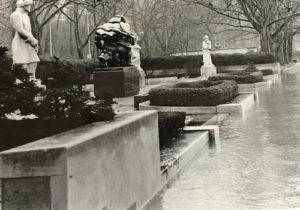
Thorfinn Karlsefni on Boathouse Row since 1920
In the early years of rowing on the Schuylkill, especially as the sport gained momentum in the 1830s and beyond, there was plenty of crime along the river. Boat club records (which exist going back to 1853) show that thieves regularly broke into the clubs, stealing their equipment. Eventually Fairmount Park in the second half of the 19th century had guards who would patrol along Boathouse Row seeking out the marauding “Park Rangers” as the thieves were called.
The Minutes of the Undine Barge Club of April 29, 1856, for instance, report burglars stealing uniforms, cups, flags and tools. In 1864, the club was broken into again and it posted a $50 reward (a lot of money at the time) “for conviction of person or persons.” The next February, Undine – which was renting space in what was then the Skating Club (now Philadelphia Girls Rowing Club) – was broken into twice more. Finally, on May 6, 1865, the minutes state that a “person by name of Morgan has been arrested and is now in prison, held on $200 bail for receiving and disposing of stolen goods.”
As for Thorfinn Karlsefni, the sagas which constitute the ancient history of Iceland, report that he traveled in 1010 with a group of explorers, as well as women and animals, to create a colony in the New World (location today unknown). His child, Snorri, legend has it, was the first Westerner born in the New World.
As for the Philadelphia statue, it was created by Icelandic sculptor Einar Jónsson.
The 1920 commission was part of a bequest left by Ellen Phillips Samuel to the former Fairmount Park Art Association. That gift, overseen by her husband, led to much of the sculpture just upriver from where the Viking stood.

Sculpture garden in flood, 1979. Temple Univ. Special Research Library